Tampa Bay area
Tampa Bay Area
Tampa–St. Petersburg–Clearwater MSA | |
|---|---|
 | |
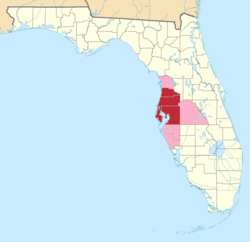 The Tampa–St. Petersburg–Clearwater Metropolitan Statistical Area (red) and other counties which are sometimes considered to be part of the Tampa Bay Area (pink). | |
| Country | United States |
| State | Florida |
| Largest city | Tampa |
| Other major cities | |
| Population (2020) | 3,175,275 |
• Estimate (2022) | 3,290,730 |
| Ranked 17th in the US | |
| GDP | |
| • MSA | $219.4 billion (2022) |
| Time zone | UTC−05:00 (EST) |
| • Summer (DST) | UTC−04:00 (EDT) |
| Area code(s) | 813, 656, 727, 352, 863 941 |
The Tampa Bay area is a major metropolitan area surrounding Tampa Bay on the Gulf Coast of Florida in the United States. It includes the main cities of Tampa, St. Petersburg, and Clearwater. It is the 17th-largest metropolitan area in the United States, with a population of 3,175,275 as of the 2020 U.S. Census.
The exact boundaries of the metro area can differ in different contexts. Hillsborough County and Pinellas County (including the cities of Tampa, St. Petersburg, Clearwater, and various smaller communities) make up the most limited definition. This area includes most of the Tampa Bay bayfront, aside from the far southern portion which lies in Manatee County. The U.S. Office of Management and Budget (OMB) defines the Tampa–St. Petersburg–Clearwater Metropolitan Statistical Area (MSA) as including Hillsborough and Pinellas Counties as well as Hernando and Pasco Counties to the north; and it is the 18th-most populous MSA in the country.[2][3] The MSA was first defined in 1950 as the Tampa-St. Petersburg, Florida Standard Metropolitan Area, and included Hillsborough and Pinellas counties. Pasco County was added to the MSA in 1973. In 1983, Hernando County was added to the MSA and Clearwater was added to the MSA name.[4] The OMB has designated Tampa, St. Petersburg, Clearwater, Largo, and Pinellas Park as the principal cities of the MSA.[5] Unlike most large metropolitan areas, Tampa does not belong to any combined statistical area and is the largest MSA in the United States not to belong to one.
Other definitions of the Tampa Bay area include:
- The four counties in the MSA plus Citrus and Manatee Counties, used by the Tampa Bay Regional Planning Council[6]
- The four counties in the MSA plus Citrus, Manatee and Sarasota Counties, used by the Tampa Bay Area Regional Transportation Authority
- The four counties in the MSA plus Citrus, Manatee, Sarasota and Polk Counties, used by the Tampa Bay Partnership[7] and the Tampa Bay media market.[8]
This wider area may also be known as West Central Florida as part of Central Florida.[9]
History
[edit]When the Spanish first arrived in the area of Tampa Bay, they encountered people of the Safety Harbor culture. About 20 sites with temple mounds have been found around Tampa Bay, with several in Pinellas County. Best known of the Safety Harbor people was the chiefdom of Tocobaga, which was likely located at the Safety Harbor site in Philippe Park in northern Pinellas County.[10]
Tampa–St. Petersburg–Clearwater Metropolitan Statistical Area
[edit]The population of the Tampa Bay MSA is 3,175,275 people as of the 2020 United States census.[11] The Office of Management and Budget now divides the MSA into the Tampa Metropolitan Division, consisting of Hillsborough, Pasco and Hernando counties, and the Saint Petersburg-Clearwater-Largo Metropolitan Division, consisting of Pinellas County.[5]
| Census | Pop. | Note | %± |
|---|---|---|---|
| 1900 | 36,013 | — | |
| 1910 | 78,314 | 117.5% | |
| 1920 | 116,552 | 48.8% | |
| 1930 | 215,668 | 85.0% | |
| 1940 | 272,000 | 26.1% | |
| 1950 | 409,143 | 50.4% | |
| 1960 | 820,443 | 100.5% | |
| 1970 | 1,105,553 | 34.8% | |
| 1980 | 1,613,603 | 46.0% | |
| 1990 | 2,067,959 | 28.2% | |
| 2000 | 2,395,997 | 15.9% | |
| 2010 | 2,783,243 | 16.2% | |
| 2020 | 3,175,275 | 14.1% | |
| 2022 (est.) | 3,290,730 | 3.6% | |
| source:[12][13][14][15][16][17][18] | |||
The following is a list of important cities and unincorporated communities, including census-designated places (CDPs), located in the Tampa–St. Petersburg–Clearwater MSA based on the 2010 U.S. Census:[18]
Municipalities and CDPs
[edit]
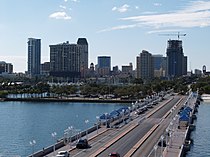
Incorporated municipalities and Census-designated places in the Tampa Bay area with more than 10,000 population.
More than 250,000 inhabitants
[edit]More than 100,000 inhabitants
[edit]
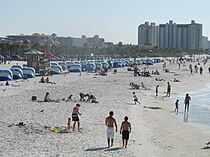

- Clearwater
- Riverview (CDP)
- Brandon (CDP)
- Spring Hill (CDP)
More than 10,000 inhabitants
[edit]
|
|
Demographics
[edit]This section needs to be updated. (April 2021) |
According to the 2000 U.S. Census, the Tampa–St. Petersburg–Clearwater MSA consists of the following ethnic demographics:
| Demographic | Tampa Bay | Percentage |
|---|---|---|
| White (Non-Hispanic/Latino) | 1,821,955 | 76.0% |
| Hispanic | 248,642 | 10.4% |
| Black | 248,058 | 10.4% |
| Asian/Pacific Islander | 57,235 | 2.4% |
Age
[edit]| Age | Tampa Bay | Percentage |
|---|---|---|
| 0–17 | 852,600 | 22.0% |
| 18–34 | 757,808 | 19.6% |
| 35–54 | 1,066,684 | 27.3% |
| 55–64 | 447,581 | 11.6% |
| 65 and over | 750,138 | 19.4% |
| Median Age | 41.39 years old |
Race and ethnicity
[edit]| Ethnicity | Tampa Bay | Percentage |
|---|---|---|
| White (non-Hispanic) | 3,141,549 | 72.3% |
| Hispanic or Latino (of any race) | 479,936 | 11.0% |
| Black | 411,157 | 9.5% |
| Asian | 77,296 | 1.8% |
| Other | 149,948 | 3.5% |
| Two or more races | 83,861 | 1.9% |
Hispanic or Latino by origin
[edit]| Ethnicity | Tampa Bay | Percentage |
|---|---|---|
| Mexican | 145,685 | 30.4% |
| Puerto Rican | 135,133 | 28.2% |
| Cuban | 63,728 | 13.3% |
| All others | 135,390 | 28.2% |
Asian by origin
[edit]| Ethnicity | Tampa Bay | Percentage |
|---|---|---|
| Indian | 28,073 | 1.01% |
| Vietnamese | 21,084 | 0.72% |
| Filipino | 12,076 | 0.35% |
| All others | 20,000 | 0.7% |
List of counties
[edit]| County | 2022 Estimate | 2020 Census | %± | Area | Density |
|---|---|---|---|---|---|
| Hillsborough County | 1,513,301 | 1,459,762 | +3.67% | 1,020 sq mi (2,600 km2) | 1,449/sq mi (560/km2) |
| Pinellas County | 961,739 | 959,107 | +0.27% | 274 sq mi (710 km2) | 3,491/sq mi (1,348/km2) |
| Pasco County | 608,794 | 561,891 | +8.35% | 747 sq mi (1,930 km2) | 782/sq mi (302/km2) |
| Hernando County | 206,896 | 194,515 | +6.37% | 473 sq mi (1,230 km2) | 424/sq mi (164/km2) |
| Total (MSA) | 3,290,730 | 3,175,275 | +3.64% | 2,514 sq mi (6,510 km2) | 1,309/sq mi (505/km2) |
| Citrus County | 162,529 | 153,855 | +5.64% | 582 sq mi (1,510 km2) | 264/sq mi (102/km2) |
| Manatee County | 429,125 | 399,705 | +7.36% | 743 sq mi (1,920 km2) | 538/sq mi (208/km2) |
| Polk County | 787,404 | 725,041 | +8.60% | 1,798 sq mi (4,660 km2) | 403/sq mi (156/km2) |
| Sarasota County | 462,286 | 434,005 | +6.52% | 556 sq mi (1,440 km2) | 781/sq mi (301/km2) |
| Total (MSA + Other Counties) | 5,132,074 | 4,887,881 | +5.00% | 6,193 sq mi (16,040 km2) | 829/sq mi (320/km2) |
Geography
[edit]The Tampa Bay area is located along Tampa Bay which it is named for. Pinellas County and St. Petersburg, Florida lies on a peninsula between Tampa Bay and the Gulf of Mexico, and much of the city of Tampa, Florida lies on a smaller peninsula jutting out into Tampa Bay.
Climate
[edit]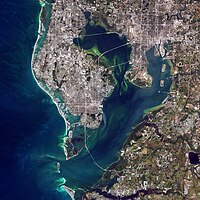
The Tampa Bay area has a humid subtropical climate (Koppen Cfa) with hot, humid summers, with daily thunderstorms, drier, predominantly sunny winters, and warm-to-hot springs with a pronounced dry season maximum. On average, two days experience frost per year in the cooler parts of the Tampa Bay area, less than annually in the coastal parts. However, hard freezes (low temperatures below 28 °F/−2 °C) are very rare, occurring only a few times in the last 75 years. The United States Department of Agriculture designates the area as being in hardiness zones 9b and 10a. Coastal parts of the Tampa Bay area closely border a tropical savanna climate (As) with many tropical microclimates due to maritime influences of the Gulf of Mexico and the 400-square-mile Tampa Bay. Plant climate-indicator species such as coconut palms and royal palms, as well as other elements of south Florida's native tropical flora, reach their northern limits of reliable culture and native range in the area.[19][20] Highs usually range between 65 and 95 °F (18 and 35 °C) year-round. Tampa's official high has never reached 100 °F (38 °C)—the all-time record high temperature is 99 °F (37 °C). St. Petersburg's all-time record high is exactly 100 °F (38 °C).[21]
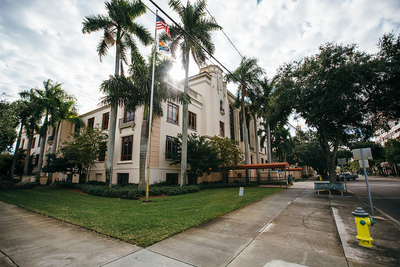
Pinellas County lies on a peninsula between Tampa Bay and the Gulf of Mexico, and much of the city of Tampa lies on a smaller peninsula jutting out into Tampa Bay. This proximity to large bodies of water both moderates local temperatures and introduces large amounts of humidity into the atmosphere. In general, the communities farthest from the coast have more extreme temperature differences, both during a single day and throughout the seasons of the year.
| Climate data for Tampa, Florida (Tampa Int'l), 1991−2020 normals,[a] extremes 1890−present[b] | |||||||||||||
|---|---|---|---|---|---|---|---|---|---|---|---|---|---|
| Month | Jan | Feb | Mar | Apr | May | Jun | Jul | Aug | Sep | Oct | Nov | Dec | Year |
| Record high °F (°C) | 86 (30) |
89 (32) |
92 (33) |
96 (36) |
98 (37) |
99 (37) |
98 (37) |
98 (37) |
96 (36) |
95 (35) |
92 (33) |
86 (30) |
99 (37) |
| Mean maximum °F (°C) | 81.8 (27.7) |
82.5 (28.1) |
85.4 (29.7) |
89.0 (31.7) |
93.4 (34.1) |
95.0 (35.0) |
94.8 (34.9) |
94.8 (34.9) |
93.8 (34.3) |
91.1 (32.8) |
86.4 (30.2) |
82.5 (28.1) |
96.2 (35.7) |
| Mean daily maximum °F (°C) | 71.3 (21.8) |
74.0 (23.3) |
77.8 (25.4) |
83.0 (28.3) |
88.3 (31.3) |
90.5 (32.5) |
91.0 (32.8) |
91.2 (32.9) |
90.2 (32.3) |
85.6 (29.8) |
78.9 (26.1) |
73.9 (23.3) |
83.0 (28.3) |
| Daily mean °F (°C) | 62.0 (16.7) |
64.7 (18.2) |
68.6 (20.3) |
73.9 (23.3) |
79.5 (26.4) |
82.9 (28.3) |
83.8 (28.8) |
84.0 (28.9) |
82.7 (28.2) |
77.4 (25.2) |
69.8 (21.0) |
64.9 (18.3) |
74.5 (23.6) |
| Mean daily minimum °F (°C) | 52.8 (11.6) |
55.5 (13.1) |
59.3 (15.2) |
64.8 (18.2) |
70.6 (21.4) |
75.4 (24.1) |
76.6 (24.8) |
76.8 (24.9) |
75.3 (24.1) |
69.2 (20.7) |
60.7 (15.9) |
55.9 (13.3) |
66.1 (18.9) |
| Mean minimum °F (°C) | 34.4 (1.3) |
38.8 (3.8) |
43.4 (6.3) |
51.6 (10.9) |
61.2 (16.2) |
69.9 (21.1) |
71.8 (22.1) |
72.5 (22.5) |
69.2 (20.7) |
54.9 (12.7) |
45.3 (7.4) |
39.5 (4.2) |
32.8 (0.4) |
| Record low °F (°C) | 21 (−6) |
22 (−6) |
29 (−2) |
38 (3) |
49 (9) |
53 (12) |
63 (17) |
66 (19) |
54 (12) |
40 (4) |
23 (−5) |
18 (−8) |
18 (−8) |
| Average precipitation inches (mm) | 2.65 (67) |
2.62 (67) |
2.52 (64) |
2.55 (65) |
2.60 (66) |
7.37 (187) |
7.75 (197) |
9.03 (229) |
6.09 (155) |
2.34 (59) |
1.40 (36) |
2.56 (65) |
49.48 (1,257) |
| Average precipitation days (≥ 0.01 in) | 7.1 | 6.6 | 5.9 | 5.7 | 6.2 | 13.3 | 16.6 | 16.2 | 12.8 | 7.2 | 4.6 | 6.0 | 108.2 |
| Average relative humidity (%) | 74.9 | 73.0 | 71.8 | 69.0 | 69.8 | 74.4 | 76.6 | 78.4 | 77.6 | 74.2 | 75.0 | 75.0 | 74.1 |
| Average dew point °F (°C) | 50.2 (10.1) |
50.7 (10.4) |
55.6 (13.1) |
59.2 (15.1) |
64.9 (18.3) |
70.9 (21.6) |
72.7 (22.6) |
73.0 (22.8) |
71.2 (21.8) |
64.2 (17.9) |
57.7 (14.3) |
52.3 (11.3) |
61.9 (16.6) |
| Mean monthly sunshine hours | 213.9 | 231.7 | 260.4 | 279.0 | 337.9 | 321.0 | 334.8 | 294.5 | 267.0 | 235.6 | 195.0 | 195.3 | 3,166.1 |
| Mean daily sunshine hours | 6.9 | 8.2 | 8.4 | 9.3 | 10.9 | 10.7 | 10.8 | 9.5 | 8.9 | 7.6 | 6.5 | 6.3 | 8.7 |
| Mean daily daylight hours | 10.6 | 11.2 | 12.0 | 12.9 | 13.5 | 13.9 | 13.7 | 13.1 | 12.3 | 11.5 | 10.8 | 10.4 | 12.2 |
| Percent possible sunshine | 65 | 73 | 70 | 72 | 81 | 77 | 79 | 73 | 72 | 66 | 60 | 61 | 71 |
| Average ultraviolet index | 4.4 | 6.1 | 8.0 | 9.6 | 10.1 | 10.4 | 10.5 | 10.1 | 8.7 | 6.7 | 4.8 | 4.0 | 7.7 |
| Source 1: NOAA (relative humidity, dew point and sun 1961−1990)[22][23][24] Weather Channel[25] | |||||||||||||
| Source 2: UV Index Today (1995 to 2022)[26] Source 3: Weather Atlas (sunshine data) [27] | |||||||||||||
Economy
[edit]This section needs additional citations for verification. (January 2015) |
As of July 1, 2019, the largest employers within the Tampa Bay area are:[28][29]
| Employer | Employees | Industry |
|---|---|---|
| BayCare Health System | 28,400 | Healthcare |
| Publix Super Markets | 25,989 | Grocery |
| Hillsborough County School District | 25,173 | Education |
| HCA West Florida Division | 18,832 | Healthcare |
| MacDill Air Force Base | 18,000 | Military |
Finance and insurance
[edit]Nearly one in four of the state's business and information services firms resides in Tampa Bay.[citation needed] These firms range from financial services firms to information technology providers to professional services organizations such as law firms, accounting firms, engineering firms, consulting and more. As a gateway to the Florida High Tech Corridor, Tampa Bay is home to many information technology firms along with many business services providers.
Financial services firms:
- Bank of America
- Capital One
- JPMorgan Chase
- Citigroup
- Wells Fargo
- Depository Trust & Clearing Corporation
- Raymond James Financial
- Franklin Templeton
- Metlife
- USAA
- Progressive Insurance
- Transamerica
- State Farm
- New York Life
Health care
[edit]With more than 50 hospitals, dozens of clinics and ambulatory care centers, the Tampa Bay has an abundance of top-rated health care facilities for children and adults. The region also has a wealth of well-trained medical professionals—nearly 53,000 nurses and more than 9,200 physicians (including physician assistants)—provide care to Tampa Bay residents and visitors every year.
Information technology
[edit]Tampa Bay serves as the gateway to the Florida High Tech Corridor which spans 23 counties. Created as a partnership between the University of South Florida, University of Central Florida and now including the University of Florida, the Florida High Tech Corridor promotes the growth of the high-tech industry across Central Florida.
Higher education and research
[edit]Academic research is a key component of high-tech growth and a powerful economic engine. The presence of cutting-edge research in the region is vital to technology transfer, which enables innovative ideas discovered in academia to achieve commercialization in the marketplace. Tampa Bay has several powerhouse research centers that are engaged in both pure scientific research and aggressively pursuing technology transfer to enrich people's lives.
Researchers at the University of South Florida's Nanomaterials and Nanomanufacturing Research Center (NNRC), H. Lee Moffitt Cancer Center and the Center for Ocean Technology at USF's College of Marine Science are researching how to use nanotechnology for a myriad of targeted uses including drug delivery, mechanized microsurgery, customized laser microchips, ways to turn sunlight into electricity, purifying water, storing hydrogen in small nanotubes, designing and developing marine sensors using microelectromechanical systems (MEMS) and curing cancer. University of Tampa is located in Downtown Tampa, Florida on the Hillsborough River and is a historic university linked back to Teddy Roosevelt.
Housing
[edit]In 2008 the area's construction based boom was brought to a sudden halt by the financial crisis of 2007–2010, and by 2009 it was ranked as the fourth worst performing housing market in the United States.[30]
Changes in house prices for the area are publicly tracked on a regular basis using the Case–Shiller index; the statistic is published by Standard & Poor's and is also a component of S&P's 20-city composite index of the value of the U.S. residential real estate market.
Avionics, defense, and marine electronics
[edit]The University of South Florida's Center for Ocean Technology, which has been a leader in microelectromechanical systems research and development and has been using the technology to collect biological and chemical data to monitor water quality, provided underwater technology for port security at the 2004 Republican National Convention. USF's Center for Robot-Assisted Search and Rescue used its miniature robots to assist rescue teams at Ground Zero following the September 11 terrorist attacks.
Tampa Bay is also the location of three major military installations, MacDill Air Force Base, Coast Guard Air Station Clearwater and Coast Guard Station St. Petersburg. MacDill AFB is home to the 6th Air Mobility Wing (6 AMW) of the Air Mobility Command (AMC) and the 927th Air Refueling Wing (927 ARW) of the Air Force Reserve Command (AFRC). Both wings share flight operations of a fleet of KC-135R Stratotanker aircraft and the 6 AMW also operates a fleet of C-37A Gulfstream V aircraft. MacDill AFB also hosts multiple tenant organizations, to include two major combatant commands: United States Central Command (USCENTCOM), which directs military operations in Afghanistan, Iraq, and the Middle East; and United States Special Operations Command (USSOCOM), which has responsibility for all special operations forces in the U.S. Armed Forces. CGAS Clearwater is located at the St. Petersburg–Clearwater International Airport. It is the largest air station in the United States Coast Guard, operating HC-130H Hercules aircraft and MH-60T Jayhawk helicopters with principal missions focused on search and rescue, counternarcotics interdiction, and homeland security. The HC-130 aircraft are slated to be replaced by new HC-27J Spartan aircraft beginning in 2017. Coast Guard Station St. Petersburg is located on the site of the former Coast Guard Air Station St. Petersburg at Albert Whitted Airport. It is home to Coast Guard Sector St. Petersburg[31] and is homeport for the USCGC Resolute (WMEC 620), USCGC Venturous (WMEC 625), and numerous smaller cutters and patrol boats.[32]
Education
[edit]
Primary and secondary education is provided by the school districts of the individual counties making up the region.
The area is home to several institutions of higher learning, including the main campus of the University of South Florida in Tampa and its satellite campuses in St. Petersburg and Sarasota. Eckerd College in St. Petersburg, the University of Tampa, Florida College in Temple Terrace, Trinity College in New Port Richey, and New College of Florida in Sarasota all four-year institutions located in the area. Embry–Riddle Aeronautical University and Troy University also maintain satellite education centers at MacDill AFB. Nova Southeastern University also has a regional campus in Clearwater.
There are two law schools in the area, Stetson University College of Law and Thomas M. Cooley Law School. Stetson University has campuses in Gulfport and Tampa, while Thomas M. Cooley Law school is located in Riverview.
Hillsborough Community College, St. Petersburg College, Polk State College, Pasco-Hernando State College, and State College of Florida are community colleges serving the area.
Culture
[edit]
The Tampa Bay area is home several art museums. Long established communities, particularly those near the bay such as Cuban influenced Ybor City, Old Northeast in St. Petersburg, and Palma Ceia and Hyde Park in Tampa contain historic architecture. Fresh seafood and locally grown produce are available in the region's restaurants and farmers' markets. Yuengling, the largest American-owned brewer, operates a brewery in Tampa, as does craft brewer Cigar City Brewing. The area is also known for its influence on heavy metal music, specifically death metal. Within both the Florida death metal scene and broader genre Tampa Bay became known as the "capital of death metal."[33][34]
In a single year, the economic impact of the cultural institutions in the Tampa Bay area was $521.3 million, according to a PricewaterhouseCoopers study.[citation needed] In 2004, 5.6 million people attended plays, musical performances, museum exhibits, and other cultural institutions in Tampa Bay, supporting 7,800 jobs.[citation needed]
Museums
[edit]
- Museum of Fine Arts near the Pier in downtown St. Petersburg
- Salvador Dalí Museum in downtown St. Petersburg
- Florida International Museum at St. Petersburg College in downtown St. Petersburg
- Florida Holocaust Museum in downtown St. Petersburg
- Tampa Museum of Art in downtown Tampa
- USF Contemporary Art Museum on the USF Tampa campus
- Florida Museum of Photographic Arts in downtown Tampa
- Museum of Science and Industry adjacent to USF's Tampa campus
- Tampa Bay Automobile Museum in Pinellas Park
- Leepa-Rattner Museum of Art on the Tarpon Springs Campus of St. Petersburg College
- The Royal Theater & Manhattan Casino Historic Landmarks in St. Petersburg
- The Carter J. Woodson African-American Museum St. Petersburg
- Tampa Bay History Center
- Ybor City Museum State Park in Ybor City
- Ringling Art Museum in Sarasota

Performing arts halls
[edit]- Straz Center for the Performing Arts in Tampa
- Ruth Eckerd Hall in Clearwater
- Mahaffey Theater in St. Petersburg
- Tarpon Springs Performing Arts Center
- Van Wezel Performing Arts Hall in Sarasota
Cultural events
[edit]- Gasparilla Pirate Festival held every January in Tampa
- Florida State Fair held every February in Tampa
- Florida Strawberry Festival held every March in Plant City
- Clearwater Jazz Holiday held every October in Coachman Park in downtown Clearwater; in its 32nd year
- Guavaween, a Latin-flavored Halloween celebration held every October in the Ybor City section of Tampa
- Festa Italiana, annual festival of Italian heritage held every April in Ybor City, Tampa's Latin Quarter
Recreation
[edit]
The Tampa Bay area is noted for its beaches, with the warm, blue gulf waters and nearly 70 miles of barrier islands from North Pinellas south to Venice. Three of the beaches in this area, Fort De Soto's North Beach (2005), Caladesi Island (2008), and Sarasota's Siesta Key (2011) have been named by Dr. Beach as America's Top Beach.[35] The 15th IIFA Awards would be held at Tampa Bay Area in April 2014.[36]
Sports attractions, in addition to the teams listed below, include professional quality golf courses, tennis courts, and pools. Ybor and the Channel District in Tampa, downtown St. Petersburg, and the beaches all along the coast all attract a vibrant nightlife.
Theme parks
[edit]- Adventure Island in Tampa
- Busch Gardens Tampa Bay in Tampa
- Dinosaur World in Plant City
- Weeki Wachee Springs in Hernando County
- Legoland Florida in Winter Haven, Polk County

Zoos and aquariums
[edit]- Lowry Park Zoo in Tampa
- Florida Aquarium in Tampa
- Clearwater Marine Aquarium in Clearwater
- Suncoast Seabird Sanctuary in Indian Shores
Botanical gardens
[edit]- Florida Botanical Gardens, part of the Pinewood Cultural Park in Largo
- Sunken Gardens in St. Petersburg, a former tourist attraction now run by the City of St. Petersburg
- USF Botanical Gardens in Tampa
- Marie Selby Botanical Gardens in Sarasota
Notable public parks and recreation areas
[edit]Hillsborough River State Park in Thonotosassa is one of Florida's eight original state parks, and Honeymoon Island State Park, near Dunedin, is Florida's most visited state park. Pinellas County is home to the Pinellas Trail, a 37-mile rail trail connecting Tarpon Springs to St. Petersburg. Skyway Fishing Pier State Park, the remnants of the approaches to the original Sunshine Skyway Bridge, forms the world's largest fishing pier in Pinellas and Manatee counties. The shallow waters and mangrove islands of the bay and gulf make the area popular with kayakers. The gulf is also home to natural and artificial coral reefs that are popular for fishing and scuba diving. Away from the coast, Circle B Bar Reserve in Lakeland (Polk county) has been designated as a Great Florida Birding Trail site, a program of the Florida Fish and Wildlife Conservation Commission.
Sports
[edit]Sports teams
[edit]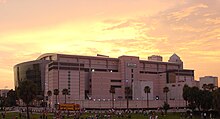


The Tampa Bay Area is home to three major professional sports teams: the Buccaneers (NFL), Rays (MLB), and Lightning (NHL).[37] The Tampa Bay area also hosts a number of minor-league and college teams.
| Team | League | Sport | Stadium | Location |
|---|---|---|---|---|
| Tampa Bay Buccaneers | NFL | American football | Raymond James Stadium | Tampa |
| Tampa Bay Lightning | NHL | Ice hockey | Amalie Arena | Tampa |
| Tampa Bay Rays | MLB | Baseball | George M. Steinbrenner Field | Tampa |
| Tampa Bay Rowdies | USL | Soccer | Al Lang Stadium | St. Petersburg |
| South Florida Bulls | NCAA DI | various[c] | various | Tampa |
| Tampa Spartans | NCAA DII | various[d] | various | Tampa |
- ^ Mean monthly maxima and minima (i.e. the highest and lowest temperature readings during an entire month or year) calculated based on data at said location from 1991 to 2020.
- ^ Official records for Tampa were kept at downtown from April 1890 to December 1940, Peter O. Knight Airport from January 1941 to 5 June 1946, and at Tampa Int'l since 7 June 1946. For more information, see ThreadEx
- ^ baseball, men's basketball, women's basketball, men's and women's cross country, football, men's and women's golf, women's sailing, men's soccer, women's soccer, softball, men's and women's tennis, men's and women's track and field (outdoor and indoor for both), and women's volleyball.[38]
- ^ Baseball, men's and women's basketball, women's beach volleyball, men's and women's cross country, men's and women's golf, men's and women's lacrosse, women's rowing, men's and women's soccer, men's and women's swimming, women's tennis, and men's and women's track and field (indoor and outdoor for both).
MLB spring training teams
[edit]Major League Baseball teams have come to the Tampa Bay area for spring training since the Chicago Cubs trained at Tampa's Plant Field in 1913 and the St. Louis Browns trained at St. Petersburg's Coffee Pot Park in 1914.[39] Grapefruit League games are still a favorite pastime for both residents and tourists alike every March. The following five Major League Baseball teams play spring training games in the Tampa Bay area:
- The New York Yankees in Tampa
- The Philadelphia Phillies in Clearwater
- The Toronto Blue Jays in Dunedin
- The Pittsburgh Pirates in Bradenton
- The Detroit Tigers in Lakeland
- The Baltimore Orioles in Sarasota
- The Atlanta Braves in North Port
Minor League baseball
[edit]Minor League baseball has also been a constant in the Tampa Bay area for over a century. The Tampa Smokers, St. Petersburg Saints, Lakeland Highlanders, and Bradenton Growers were charter members of the original Florida State League, which began play in 1919 and is now a Class A league. Current local teams of the FSL include:
- The Tampa Tarpons: George M. Steinbrenner Field in Tampa
- The Clearwater Threshers: Spectrum Field in Clearwater
- The Dunedin Blue Jays: TD Ballpark in Dunedin
- The Bradenton Marauders: LECOM Park in Bradenton
- The Lakeland Flying Tigers: Publix Field at Joker Marchant Stadium in Lakeland
The area is also home to several affiliates of the Florida Complex League, a rookie league in which young players gain their first experience in professional baseball.
Basketball
[edit]The Tampa Bay area does not have a professional basketball team. The Orlando Magic are the closest NBA team to the area, 85 miles east. The Toronto Raptors made Tampa their temporary home prior to the 2020–21 NBA season during the COVID-19 pandemic, necessitated by restrictions on travel between Canada and the United States that were in effect. Their "home" games were played at Amalie Arena.
The Tampa Bay area had several teams in minor basketball leagues. The Tampa Bay Titans played in The Basketball League (TBL) from 2019-2022. Their home games were played at Pasco–Hernando State College. The St. Pete Tide and the Tampa Gunners played in the Florida Basketball Association (FBA). The Tide's home games were played at St. Petersburg Catholic High School, and the Gunners were a travel team.
Sporting events
[edit]Major League sports
[edit]- Five Super Bowls have been held in Tampa: Super Bowl XVIII in 1984, Super Bowl XXV in 1991, Super Bowl XXXV in 2001, Super Bowl XLIII in 2009, and Super Bowl LV in 2021. Super Bowls XVIII and XXV were played at Tampa Stadium, while Super Bowls XXXV, XLIII and LV were played at Raymond James Stadium. The 1978 AFC–NFC Pro Bowl was held in Tampa at Tampa Stadium.
- The 2008 MLB World Series; Games 1 and 2 were played in St. Petersburg at Tropicana Field.
- The 1999 NHL All-Star Game was held in Tampa at the Ice Palace. It was held again in 2018, having been renamed Amalie Arena by then.
- The 2004 Stanley Cup Finals; Games 1, 2, 5 and 7 were played in Tampa at the St. Pete Times Forum, Games 1, 2, and 5 of the 2015 Stanley Cup Finals were played at Amalie Arena and Games 1, 2, and 5 of the 2021 Stanley Cup Finals were played at Amalie Arena .
NCAA sports
[edit]- The NCAA football Outback Bowl is held annually at Raymond James Stadium, usually on January 1. The Gasparilla Bowl is also held annually at Raymond James Stadium, usually in December. It began in 2008 at Tropicana Field in St. Petersburg until moving to Tampa in 2018. The NCAA football East–West Shrine Game is held annually at Tropicana Field since 2012, usually in January.
- The 2017 College Football Playoff National Championship was held at Raymond James Stadium on January 9, 2017.
- Two NCAA football ACC Championship Games (2008 and 2009) have been played in Tampa at Raymond James Stadium.
- Amalie Arena in Tampa has been the site for various rounds of NCAA Men's and Women's basketball championship tournament over the years, as well as conference tournaments. The 1999 NCAA Men's Final Four was held in St. Petersburg at Tropicana Field. The 2008, 2015 NCAA Women's Final Four and 2019 NCAA Division I women's basketball tournament Final Four were held in Tampa at the Tampa Bay Times Forum/Amalie Arena.
- Five NCAA Division I Men's Soccer Championships have been held in Tampa: 1978, 1979, 1980, 1990 and 1991
- The 2012 and 2016 NCAA Men's Frozen Four were held in Tampa at the Tampa Bay Times Forum/Amalie Arena.
- Tampa will host the 2023 Division I NCAA Women's Volleyball Championship, the 2023 NCAA Division I Men's Frozen Four, the 2025 NCAA Division I Women's Basketball Final Four and the 2026 NCAA Division I Men's Basketball First and Second Rounds, all at Amalie Arena.[40]
Transportation
[edit]Air
[edit]Tampa International Airport is the largest airport in the region. In addition, St. Pete–Clearwater International Airport and Sarasota–Bradenton International Airport provide access to commercial airliners, and smaller charter craft. Throughout the area are general aviation airports.
Rail
[edit]Amtrak provides passenger rail service from Union Station in Tampa. CSX provides freight rail service for the region.
Water
[edit]
The Cross-Bay Ferry has connected Tampa's Channelside District to Downtown St. Petersburg since 2016.[41] The Pirate Water Taxi, also operating since 2016, has several stops along the waterways in the vicinity of Tampa's downtown area and Channelside District.[42]
Transit systems
[edit]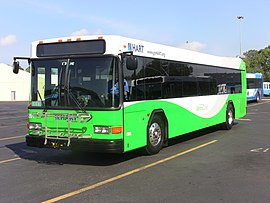


Bus service is provided in Hillsborough County by Hillsborough Area Regional Transit (HART), in Pinellas County by Pinellas Suncoast Transit Authority (PSTA), in Pasco County by Pasco County Public Transportation and in Hernando County by THE Bus. HART and PSTA provide express services between Tampa and Pinellas County, and PSTA provides connections to Pasco County. HART also operates the TECO streetcar between Downtown Tampa and Ybor City. In 2013, HART also began operating a Bus rapid transit system called MetroRapid that runs from Downtown Tampa to the University of South Florida.
On July 1, 2007, an intermodal transportation authority was created to serve the seven-county Tampa Bay area. The Tampa Bay Area Regional Transportation Authority (TBARTA) was formed to develop bus, rapid transit, and other transportation options for the region.
Roads and freeways
[edit]The Tampa Bay area is served by these interstate highways.
Hillsborough County is also served by other roadways such as the Lee Roy Selmon Expressway (SR 618) which commutes workers from Brandon into downtown Tampa and the Veterans Expressway/Suncoast Parkway (SR 589) which serves traffic from the Citrus/Hernando County border southward into Tampa. Both of these highways, which are built to limited access freeway standards, are toll roads as is the connecting junction between the Selmon Expressway and Interstate 4.
In Pinellas County, U.S. 19 is the main north–south route through the county, and is being upgraded to freeway standards complete with frontage roads to ease congestion through the north part of the county. Also, the Bayside Bridge allows traffic to go from Clearwater into St. Petersburg without having to use U.S. 19.
The Courtney Campbell Causeway (SR 60) is one of the three roads that connect Pinellas County to Hillsborough County across the bay. The other two are the Howard Frankland Bridge (I-275) and Gandy Bridge (U.S. 92). The Sunshine Skyway Bridge is part of I-275 and connects Bradenton and other Manatee County and Sarasota County commuters into Pinellas County.
See also
[edit]References
[edit]- ^ "Total Gross Domestic Product for Tampa-St. Petersburg-Clearwater, FL (MSA)". fred.stlouisfed.org.
- ^ "List of Counties Within MSAs". Census.gov. U.S. Census Bureau. Archived from the original on February 17, 2017. Retrieved October 8, 2016.
- ^ "Map of Tampa-St. Petersburg-Clearwater MSA" (PDF). United States Census Bureau, U.S. DEPARTMENT OF COMMERCE, Economics and Statistics Administration. Retrieved January 22, 2020.
- ^ "Metro Area History 1950–2020". U.S. Census Bureau. March 2020. Row 4983. Retrieved July 27, 2023.
- ^ a b "Revised Delineations of Metropolitan Statistical Areas, Micropolitan Statistical Areas, and Guidance on the Uses of the Delineations of These Areas" (PDF). Executive Office of the President. July 21, 2023. p. 74. Retrieved July 27, 2023.
- ^ "Tampa Bay Regional Planning Council: Our Mission". Retrieved August 18, 2017.
- ^ "Tampa Bay Partnership: History". Retrieved August 18, 2017.
- ^ "Nielsen Markets 2016" (PDF).
- ^ "Your Vacation Guide to Central West Florida". Visit Florida. Retrieved June 30, 2019.
- ^ Perry, Mac (September–October 1993). "Making the Mounds". Tampa Bay Magazine. Vol. 8, no. 5. pp. 60–61. Archived from the original on January 2, 2023.
- ^ "2020 Population and Housing State Data". United States Census Bureau, Population Division. August 12, 2021. Retrieved August 14, 2021.
- ^ "1950 Vol. I. Number of Inhabitants". Census.gov. U.S. Census Bureau. Retrieved October 8, 2016.
- ^ "1960 Vol. I. Characteristics of the Population, Part A, Number of Inhabitants - 11 Florida". Census.gov. U.S. Census Bureau. Retrieved October 8, 2016.
- ^ "1970 Vol. I. Characteristics of the Population, Part A, Number of Inhabitants - 11 Florida, Section 1". Census.gov. U.S. Census Bureau. Retrieved October 8, 2016.
- ^ "1980 Vol. I. Characteristics of the Population, Part A, Number of Inhabitants - 11 Florida, Section 1". Census.gov. U.S. Census Bureau. Retrieved October 8, 2016.
- ^ "1990 1990 Census of Population: General Population Characteristics Report Number: CP-1 General Population Characteristics Florida Section 1" (PDF). Census.gov. U.S. Census Bureau. Retrieved October 8, 2016.
- ^ "2000 PHC-1. Summary Population and Housing Characteristics, General Population Characteristics Florida Section 1" (PDF). Census.gov. U.S. Census Bureau. Retrieved October 8, 2016.
- ^ a b "2010 CPH-1. Summary of Population and Housing Characteristics, Florida: 2010 Summary Population and Housing Characteristics" (PDF). Census.gov. U.S. Census Bureau. Retrieved October 8, 2016.
- ^ Tomlinson, Philip Barry (1980). The Biology of Trees Native to Tropical Florida. Allston, Massachusetts U.S.A.: Harvard University Printing Office. pp. 1, 8–10.
C.S. Sargent designated ...major "tree regions" of [North America] ...each distinguished by a complex of tree species... [The] smallest of these ...called "Tropical Florida" ...[in which] 87.5% have an otherwise tropical distribution; in Florida they are at [their] northern limit. ...The distribution of tropical tree species within South Florida is not known in any detail although the generalized distribution of all species is well summarized by Little (1978). A single latitudinal line does not separate the foras of South and Central Florida... Since the factor limiting the distribution of tropical species in a northern direction is almost certainly minimum winter temperature, an approximate indication of the limits... is the 54-degF January isotherm for the state. Figure 5
- ^ Little, Elbert L. Jr. (1978). "Introduction". Atlas of United States Trees. Vol. 5 (Florida). US Government Printing Office. p. 1. LCCN 79-653298. OCLC 241660.
This is the fifth volume of an Atlas with large maps showing the natural distribution or range of the native tree species of the continental United States. In these five volumes, maps of nearly all native tree species of the continental United States have been published... Florida merits a separate volume because it has more native tree species than any other state (except Hawaii), and because it has a large number of tropical species found in no other State. These trees of mostly limited range can be shown better on large-scale maps.
- ^ "Tampa Weather Forecasts Archived 2008-12-16 at the Wayback Machine" Yahoo! Weather. Retrieved on February 6, 2009.
- ^ "NOWData – NOAA Online Weather Data". National Oceanic and Atmospheric Administration. Retrieved May 23, 2021.
- ^ "Summary of Monthly Normals 1991–2020". National Oceanic and Atmospheric Administration. Retrieved May 23, 2021.
- ^ "WMO Climate Normals for TAMPA/INT'L ARPT FL 1961–1990". National Oceanic and Atmospheric Administration. Retrieved July 18, 2020.
- ^ "Average Weather for Tampa, FL - Temperature and Precipitation". The Weather Channel. Retrieved October 3, 2011.
- ^ "Historical UV Index Data - Tampa, FL". UV Index Today. Retrieved April 21, 2023.
- ^ "Tampa, Florida - Monthly weather forecast and Climate data". Weather Atlas. Retrieved May 19, 2023.
- ^ Major Employers Archived February 26, 2015, at the Wayback Machine, Tampa Bay Partnership.
- ^ "Largest Employers in Tampa Bay". Tampa Bay Business Journal. Retrieved April 13, 2020.
- ^ "Is Florida the Sunset State?". Time. July 10, 2008. Archived from the original on July 14, 2008.
- ^ "District 7".
- ^ "USCG: About Us - Aircraft & Cutters". Archived from the original on December 28, 2006.
- ^ Guzzo, Paul (December 11, 2018). "Death metal pioneers seek site to replace Temple Terrace studio". Tampa Bay Times. Retrieved June 25, 2021.
- ^ Stevenson, Arielle (October 22, 2009). "The way the music died: The earliest days of Tampa Death Metal". Tampa Bay Times. Times Publishing Company. Archived from the original on October 27, 2009. Retrieved June 25, 2021.
- ^ "Dr. Beach: America's Foremost Beach Expert". Archived from the original on March 5, 2013. Retrieved January 18, 2012.
- ^ "Florida hopes a rise in Indian Tourists after hosting IIFA 2014". IANS. news.biharprabha.com. Retrieved February 15, 2014.
- ^ Trigaux, Robert (December 1, 2014). "How high can the value of the Bucs, Rays and Lightning go?". Tampa Bay Times.
- ^ "USF Athletics - Official Athletics Website". USF Athletics. Retrieved May 2, 2021.
- ^ Baseball in Tampa Bay, A.M. de Quesada, Arcadia Publishing, 2000.
- ^ "Athletics to Host Three Upcoming NCAA Championship Events in Tampa". USF Athletics. Retrieved October 20, 2020.
- ^ Brezina-Smith, Veronica (October 30, 2019). "Tampa, St. Pete officials tout Cross Bay Ferry as new season kicks off". Tampa Bay Business Journal. Retrieved December 5, 2019.
- ^ Brezina-Smith, Veronica (July 11, 2019). "Pirate Water Taxi invests $1.6M into fleet expansion". Tampa Bay Business Journal. Retrieved December 5, 2019.

